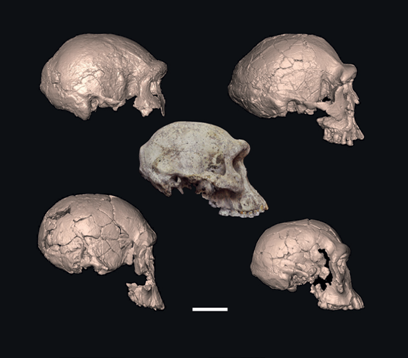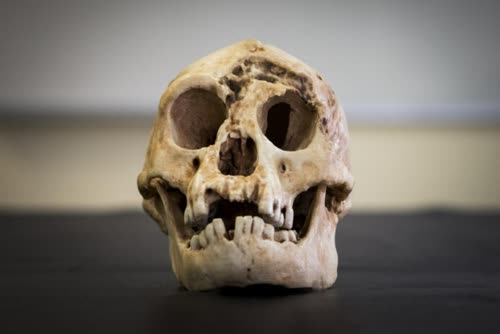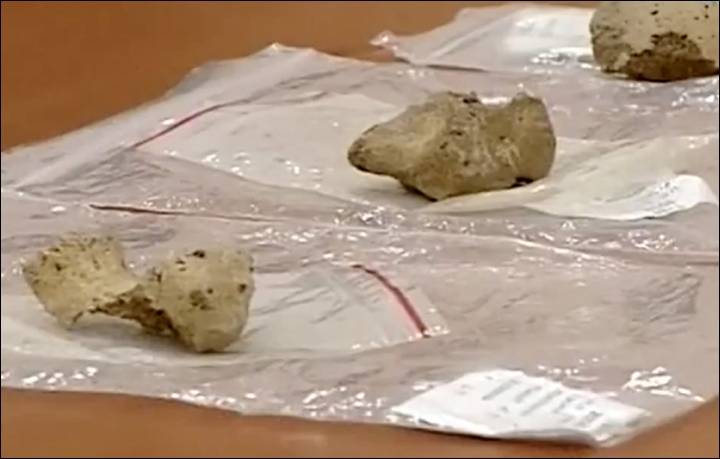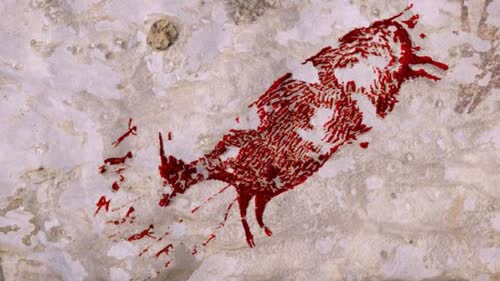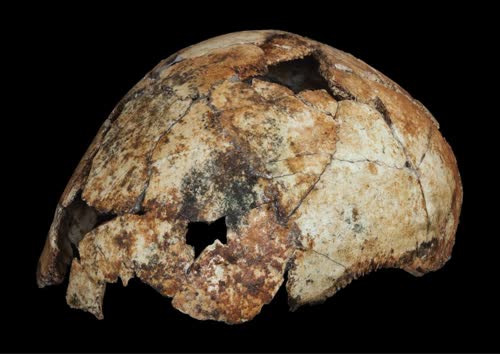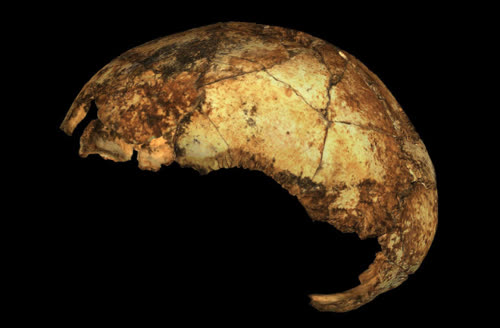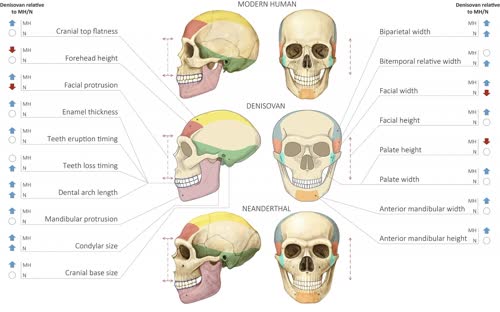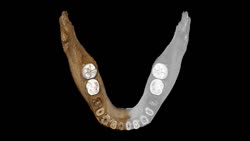|
Did the loss of endogenous ascorbate propel the evolution of Anthropoidea and Homo sapiens? Abstract |
|
Complete skull from Dmanisi- 1.78-million years old "Scientists have unearthed a complete skull from Dmanisi, Republic of Georgia, which combines traits found in early Homo skulls from Africa. The 1.78-million-year-old find has a large brow typical of Homo erectus, the small brain of Homo habilis, and large teeth similar to Homo rudolfensis – all recognized as separate species in East Africa." |
|
Stone Tools Point to Mysterious Neighbor of Flores ‘Hobbit’ The sharp-edged stones were made at least 60,000 years before modern humans reached the island of Sulawesi—but who made them? |
|
Earliest Human Presence in North America Dated to the Last Glacial Maximum: New Radiocarbon Dates from Bluefish Caves, Canada Abstract The timing of the first entry of humans into North America is still hotly debated within the scientific community. Excavations conducted at Bluefish Caves (Yukon Territory) from 1977 to 1987 yielded a series of radiocarbon dates that led archaeologists to propose that the initial dispersal of human groups into Eastern Beringia (Alaska and the Yukon Territory) occurred during the Last Glacial Maximum (LGM). This hypothesis proved highly controversial in the absence of other sites of similar age and concerns about the stratigraphy and anthropogenic signature of the bone assemblages that yielded the dates. The weight of the available archaeological evidence suggests that the first peopling of North America occurred ca. 14,000 cal BP (calibrated years Before Present), i.e., well after the LGM. Here, we report new AMS radiocarbon dates obtained on cut-marked bone samples identified during a comprehensive taphonomic analysis of the Bluefish Caves fauna. Our results demonstrate that humans occupied the site as early as 24,000 cal BP (19,650 ± 130 14C BP). In addition to proving that Bluefish Caves is the oldest known archaeological site in North America, the results offer archaeological support for the “Beringian standstill hypothesis”, which proposes that a genetically isolated human population persisted in Beringia during the LGM and dispersed from there to North and South America during the post-LGM period. |
|
The Hobbit: A Lineage More Ancient Than Once Thought? But where, exactly, it came from has been a mystery. There were suggestions that it was simply a modern human subjected to dwarfism, but characteristics in its skeleton made it seem more like a Homo erectus relative.
|
|
50,000 year old Siberian bones may be the ‘oldest Homo sapiens' outside Africa and Middle East If the discovery in Buryatia is verified as being Homo sapiens, it will alter scientific thinking about the arrival of man in Siberia.
|
|
2018: Hominid fossils in China from 2.1 million years ago. Hominin occupation of the Chinese Loess Plateau since about 2.1 million years ago, Zhu et. al. 2018
|
|
The Hunt for the Ancient ’Hobbit’s’ Modern Relatives A group of pygmies still lives near the cave where the short-statured Homo floresiensis was discovered. But they are not related. |
|
2018 - Earliest known hominin activity in the Philippines by 709 thousand years ago Over 60 years ago, stone tools and remains of megafauna were discovered on the Southeast Asian islands of Flores, Sulawesi and Luzon, and a Middle Pleistocene colonization by Homo erectus was initially proposed to have occurred on these islands. However, until the discovery of Homo floresiensis in 2003, claims of the presence of archaic hominins on Wallacean islands were hypothetical owing to the absence of in situ fossils and/or stone artefacts that were excavated from well-documented stratigraphic contexts, or because secure numerical dating methods of these sites were lacking. As a consequence, these claims were generally treated with scepticism5. Here we describe the results of recent excavations at Kalinga in the Cagayan Valley of northern Luzon in the Philippines that have yielded 57 stone tools associated with an almost-complete disarticulated skeleton of Rhinoceros philippinensis, which shows clear signs of butchery, together with other fossil fauna remains attributed to stegodon, Philippine brown deer, freshwater turtle and monitor lizard. All finds originate from a clay-rich bone bed that was dated to between 777 and 631 thousand years ago using electron-spin resonance methods that were applied to tooth enamel and fluvial quartz. This evidence pushes back the proven period of colonization6 of the Philippines by hundreds of thousands of years, and furthermore suggests that early overseas dispersal in Island South East Asia by premodern hominins took place several times during the Early and Middle Pleistocene stages1,2,3,4. The Philippines therefore may have had a central role in southward movements into Wallacea, not only of Pleistocene megafauna7, but also of archaic hominins. |
|
Evidence man was in North America 30,000 years ago The peopling of the Americas marks a major expansion of humans across the planet. However, questions regarding the timing and mechanisms of this dispersal remain, and the previously accepted model (termed ‘Clovis-first’)—suggesting that the first inhabitants of the Americas were linked with the Clovis tradition, a complex marked by distinctive fluted lithic points1—has been effectively refuted. Here we analyse chronometric data from 42North American and Beringian archaeological sites using a Bayesian age modelling approach, and use the resulting chronological framework to elucidate spatiotemporal patterns of human dispersal. We then integrate these patterns with the available genetic and climatic evidence. The data obtained show that humans were probably present before, during and immediately after the Last Glacial Maximum (about 26.5–19thousand years ago)2,3 but that more widespread occupation began during a period of abrupt warming, Greenland Interstadial1 (about 14.7–12.9thousand years before 2000)4. We also identify the near-synchronous commencement of Beringian, Clovis and Western Stemmed cultural traditions, and an overlap of each with the last dates for the appearance of 18now-extinct faunal genera. Our analysis suggests that the widespread expansion of humans through North America was a key factor in the extinction of large terrestrial mammals. |
|
A late Middle Pleistocene Denisovan mandible from the Tibetan Plateau A late Middle Pleistocene Denisovan mandible from the Tibetan Plateau |
|
New Species of Ancient Human Found in Philippines At the northern tip of the Philippine island of Luzon lies Callao Cave, an expansive, seven-chamber limestone warren. In April, researchers reported in the journal Nature that they’d uncovered the bones of a now-extinct, previously unknown human species near the far end of the first chamber. The discovery adds to growing evidence that human evolution and dispersal out of Africa is much more complicated than scientists once thought — and that we’re just starting to understand Southeast Asia’s role in that story.
|
|
Sulawesi art: Animal painting found in cave is 44,000 years old A painting discovered on the wall of an Indonesian cave has been found to be 44,000 years old.
|
|
Fossil find suggests Homo erectus emerged 200,000 years earlier than thought These discoveries, combined, have led scientists to set Homo erectus‘ emergence at about 1.8 million years ago – with the oldest known record coming from Dmanisi, Georgia and an important slightly later record from the East African Rift valley.
|
|
Two-million-year-old skull of human 'cousin' unearthed Australian researchers say the discovery of a two-million-year-old skull in South Africa throws more light on human evolution. |
|
Homo Erectus Is 200,000 Years Older Than Previously Thought For eight years, a crunched cranium protruded from an excavation pit in South Africa’s Drimolen Cave. Archaeologists ignored the fossil, assuming it to be a baboon, until they swept up pieces that had crumbled free in 2015. Early on, the remains looked more human than monkey.
|
|
Mystery ancestor mated with ancient humans. And its 'nested' DNA was just found. Today's humans carry the genes of an ancient, unknown ancestor, left there by hominin species intermingling perhaps a million years ago.
|
|
A new and as yet unkown species within Homo from West Africa. Another, and as yet unknown species of man shows up in DNA analysis of West African Homo sapiens, that predates both Neanderthal and Denisovan man.
|
|
Massive human head in Chinese well forces scientists to rethink evolution “The important thing is the third lineage of later humans that are separate from Neanderthals and separate from Homo sapiens.” |
|
Fossil footprints show humans in North America more than 21,000 years ago The footprints, the earliest firm evidence for humans in the Americas, show that people must have arrived here before the last Ice Age. |
|
Experts Name New Species of Human Ancestor An international team of researchers, led by University of Winnipeg palaeoanthropologist Dr. Mirjana Roksandic, has announced the naming of a new species of human ancestor, Homo bodoensis. This species lived in Africa during the Middle Pleistocene, around half a million years ago, and was the direct ancestor of modern humans.
|
|
Child fossil find in South Africa sheds light on enigmatic hominids Fossils found deep in a South African cave formed part of a hominid child's skull, apparently left on an alcove by fellow members of her species 250,000 years ago, scientists said on Thursday.
|
